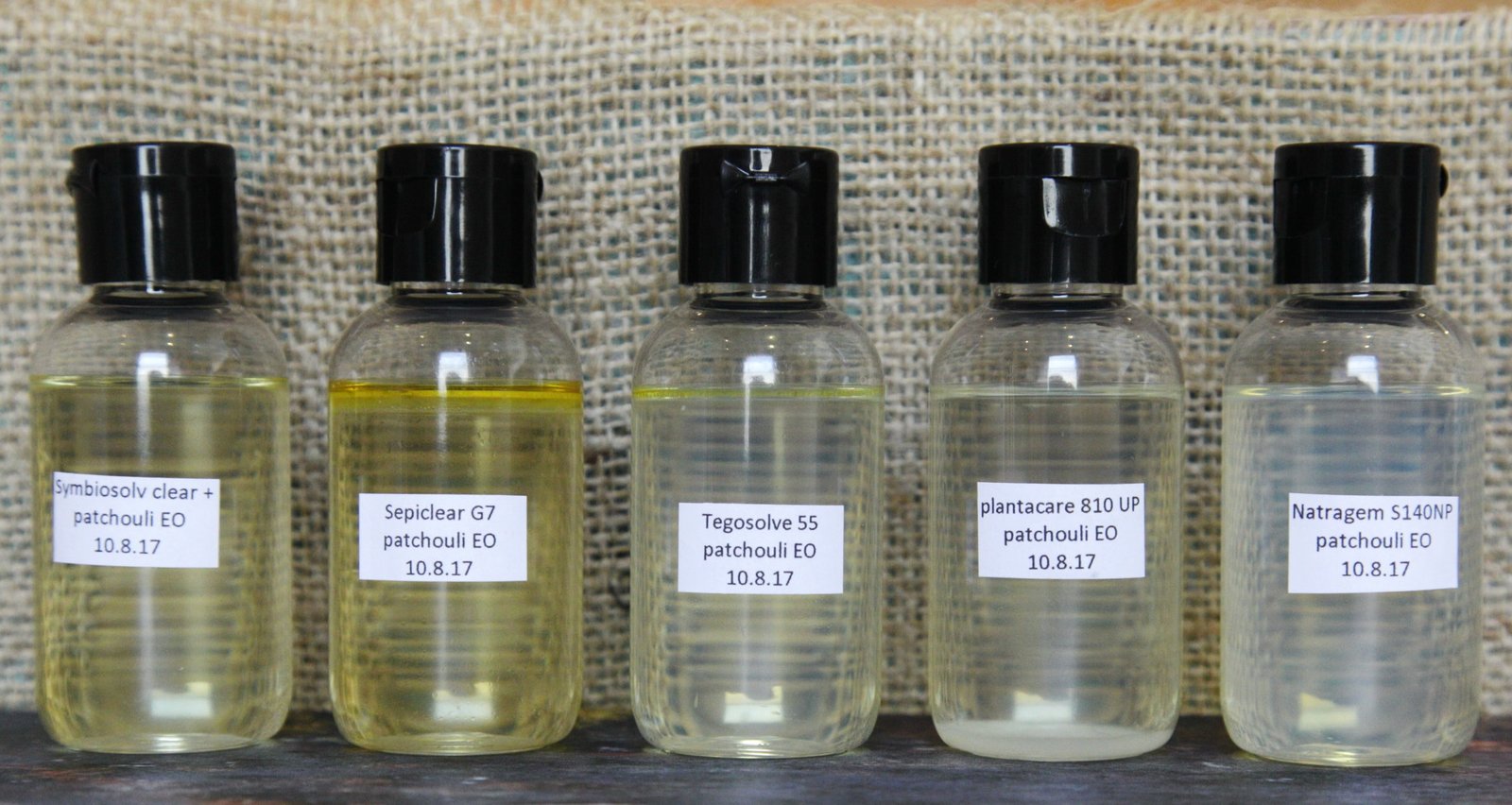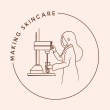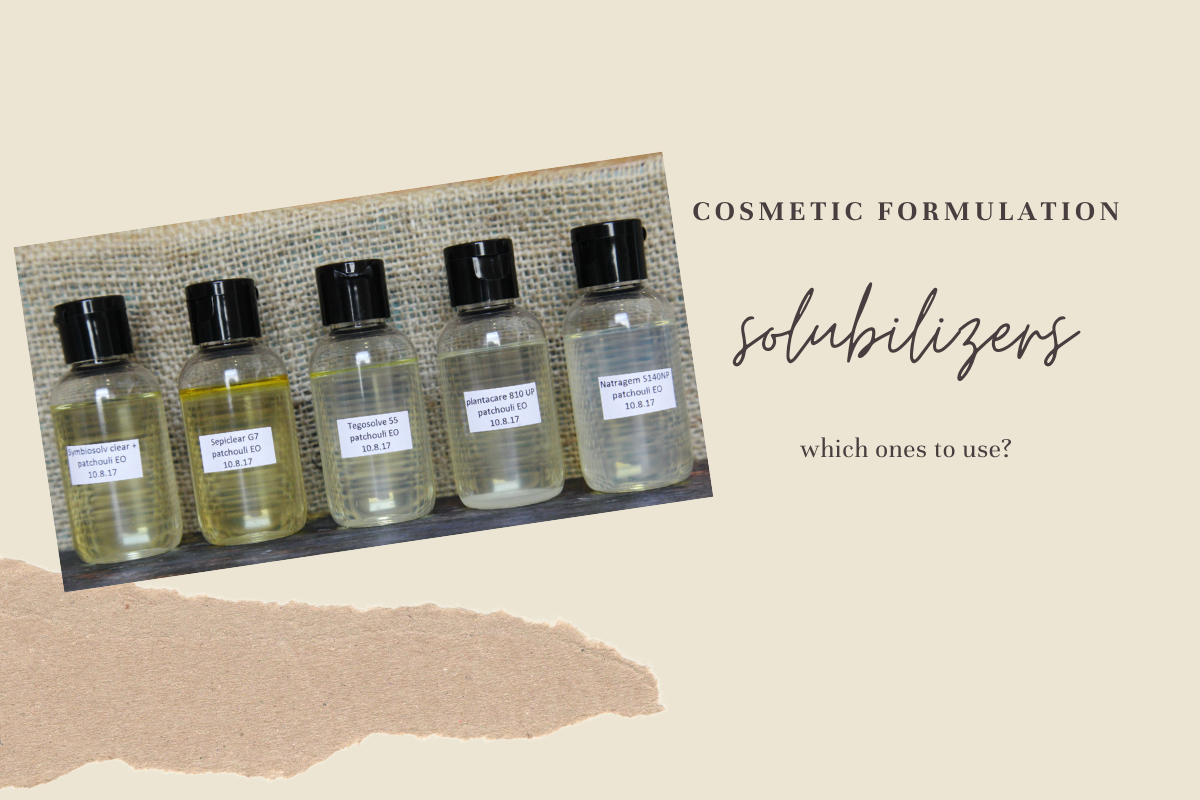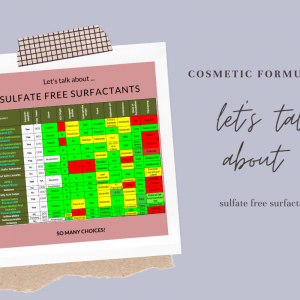
In this article we examine solubilizers, how to use them and review the performance of a selection of “natural” solubilizers.
We are frequently asked how solubilizers differ from emulsifiers. Solubilizers and high HLB emulsifiers are both surfactants which help disperse oils in water. Solubilizers are more water soluble than emulsifiers and are used to incorporate very low level (usually less than 2% total lipids) into an aqueous formula such as a shampoo, shower gel, toner to obtain a transparent formula. The aim is usually for the formula to be clear, unlike an emulsion (with emulsifiers) which contains substantially more oils and is usually white. If the oil phase particle size is small enough it will be clear.
How to use a solubilizer. The solubilizer is mixed directly with the oils and this is then added to the water. Generally speaking, the amount of solubilizer required will depend on the polarity of the oils to be solubilized. The more polar the oils, the less solubilizer is needed. Formulators using synthetic solubilizers usually start with three parts solubilizer to one part oil. For “natural” solubilizers it is recommended to start with six parts solubilizer to one part oil. If the product remains cloudy or oil is floating on the surface, more solubilizer should be added.
The key historic benchmark solubilizer is PEG 40 hydrogenated castor oil. Many formulators also use polysorbate 20 and polysorbate 80. These solubilizers are synthetic and in our discussion group we are often asked to recommend “natural” solubilizers.
We tested five “natural” solubilizers with patchouli, rosemary and lavender essential oils at varying concentrations. We also examined the price of the solubilizers as this is an important consideration for most formulators. When comparing this, at the time of testing (10 August 2017), Symbiosolv clear plus was approximately 3.5 times the price of Natragem S140. The other solubilizers (Sepiclear G7, Tegosolve 55, Plantacare 810 UP) were also priced significantly less than Symbiosolv clear plus, however, Natragem proved the most cost effective. Symbiosolv clear plus is sold here and Natragem S140NP is sold here. For a general list of worldwide ingredient suppliers click here. For Europe click here and for the USA click here.
In our tests, patchouli essential oil was the most challenging to solubilize and the photo below shows six parts solubilizer to one part patchouli.
The overall winners are Tegosolve 55 and Natragem S140NP which both performed consistently well with the different essential oils and concentrations tested.





This is inspiring me to play with my samples. I’m impressed with the Symbiosolv clear. I like that it does not change the color of the patch EO. What about adding a preservative? I guess I’ll just have to roll up my sleeves!
Our preservative article in the Knowledge Base section of our site contains all you need to know about preservatives. Let us know how you get on with your tests.
The plantacare looks the clearest of all in the patchouli eo test photo, why is plantacare not a top choice?
Hi Jade, if you look at the bottom of the bottle of labelled “plantacare” you’ll see a white colour. This happened in all the samples.
Does the white colour at the bottom of the plantacare bottle mix when it is shaken? If so, does it resettle to the bottom when still?
It resettles again unfortunately.
Thank you for the information, this is such a helpful article. The USA supplier mentioned in the article (formulator sample shop) for Natragem no longer has this product listed on their site. Do you know of any other US suppliers? Thank you for the help!
Hi Carol, glad the article was helpful. Unfortunately no DIY resellers currently sell natragem S140 NP.
Regarding Jade’s question & your response:
i’m sorry,..to clarify, no pun intended, ‘..This happened in all the samples..’; meaning, all the samples of ‘plantacare’ & the patchouli essential oil? (maybe in varying ratios?), all samples of ‘plantacare’ w/all the essential oils tested?, or all of the natural solubilizers w/all of the essential oils?
i did not see the precipitate either until you pointed it out, but i’m taking for granted there may be other things i’m not seeing or noticing in the photo now..are there various amounts of sediment or other textural inconsistencies in any of the other samples, that might not be visibily discernible to those of us just looking at the photograph? i know that might sound rather redundant or simplistic, but the Tegosolve has what looks like a thin yellow layer atop the mostly clear solution & the Natragem, although i agree it looks the most uniformly incorporated, has a slight hazy cast..
Please don’t misunderstand! This is an exceptionally helpful article!
But, out of a super rude but tenacious curiosity, i just would love to hear any other details you might have..for instance, how do you think these 5 compare, in your opinion, to the polysorbates 20 & 80, that you mentioned?
Sincerely & w/great respect, suki
Hi Suki, it happened in the samples with the other essential oils also. It is hard to tell, as you point out, from photos how the solubilisers performed and my comments in the article are general. Synthetic solubilisers such as polysorbate 20 and 80 which you mention perform in general much better than “natural” solubilisers. You might be interested to read our “How to formulate like a pro” article in the Knowledge Base section.
Thank you for the article. I really enjoyed reading but would ask for the best of the 5 and how to incorporate in a product. Also I need a list of suppliers since am writing from Nigeria.
Have been unable to get hold of Tegosolve 55, it also looks like there is an oily layer on the top, is that right?
The Natragem looks better in the pic, it’s gone cloudier, but it’s manageable. What was your opinion of the Natragem when it was applied to skin or sprayed? Also where did you get Tegosolve and Natragem from?
Harry B, The overall winners are Tegosolve 55 and Natragem S140NP which both performed consistently well with the different essential oils and concentrations tested. When applied to the skin most of the testers performed similarly however Sepiclear was stickier than the others. Unfortunately Tegosolve 55 and Natragem S140NP are not available from DIY resellers. I obtained them directly from Evonik and Croda.
These articles are so helpful, thank you. I’m new to formulating so please forgive what will seem a basic question. I am making a moisturising cream with butters, waxes and some liquid oils and using an emulsifying wax, however after a few weeks I have noticed some small areas of greasy separation and wondering if I should I use a solubilizer for the essential oils and vitamin e before adding them to the cooled water phase? Thank you.
This article will help you solve the issue: https://makingskincare.com/emulsions-stability/
Hi Iam so glad i found your site its very helpful. I read this article about solubilizers and if you could tell me about usage in perfumes , i want to add perfume or essential oil at the end of formula so my question is can i dissolve perfume in polysorbate 20 and if you recommend something else and what ratio, i also heard about triethyl citrate if you can help me with that as well.
Thanks
Tanya
Hi Tanya, it will depend on the rest of your formula. Please post the full formula in % here: https://www.facebook.com/groups/makingskincare and also take a look at our “How to formulate like a pro article”.